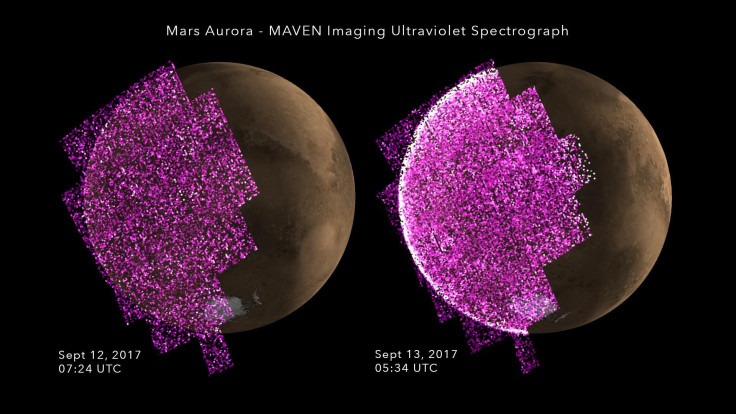Solar Storm Hits Mars, Causes Planet-Wide Aurora

The auroras on Earth, caused by the interaction of coronal mass ejections from the sun with the planet’s magnetic field, are mostly centered over or near the north and south poles, and people travel to places from where the dazzling display of lights in the sky is visible. But what if an aurora covered the entire planet?
That may not be possible on Earth, given its strong magnetic field that concentrates the aurora near the poles, but that is precisely what happened on Mars in the second week of September. The solar event that caused this global aurora on the red planet occurred Sept. 11 and its effect was observed by a multitude of Mars-observing instruments over the following two days.
One of the missions that observed this unusual and unexpected occurrence was NASA’s Mars Atmosphere and Volatile Evolution, or MAVEN. It has been looking at the Martian atmosphere from its vantage point in orbit around Mars since September 2014, and the global aurora seen Sept. 12-13 was “more than 25 times brighter than any previously seen” by it, according to a NASA statement Friday.
The images were produced by MAVEN’s Imaging Ultraviolet Spectrograph. So, even if you happened to be in the vicinity of Mars, you would not have been able to see the aurora in its glorious intensity because our eyes cannot see in the ultraviolet spectrum of light.
Even the radiation levels produced on the Martian surface as a result of the solar activity were “more than double any previously measured” by the Radiation Assessment Detector (RAD) instrument on NASA’s Curiosity rover since it landed on the Martian surface 5 years ago, the statement said.
“If you were outdoors on a Mars walk and learned that an event like this was imminent, you would definitely want to take shelter, just as you would if you were on a space walk outside the International Space Station. To protect our astronauts on Mars in the future, we need to continue to provide this type of space weather monitoring there,” Don Hassler of the Southwest Research Institute's Boulder, Colorado, office, who is also the principle investigator for RAD, said in the statement.
Even though Earth was on the opposite side of the sun from Mars, the event could still be detected here, and astronomers studied it in detail. Other than the unusual intensity, the other remarkable aspect of the recent planet-wide Martian aurora was that it happened at a time when solar activity is about to hit the lowest point of the 11-year sun-spot and storm-activity cycle the sun goes through.
“The current solar cycle has been an odd one, with less activity than usual during the peak, and now we have this large event as we’re approaching solar minimum,” Sonal Jain of the University of Colorado Boulder'’s Laboratory for Atmospheric and Space Physics, who is a member of MAVEN’s Imaging Ultraviolet Spectrograph instrument team, said in the statement.
© Copyright IBTimes 2024. All rights reserved.





















